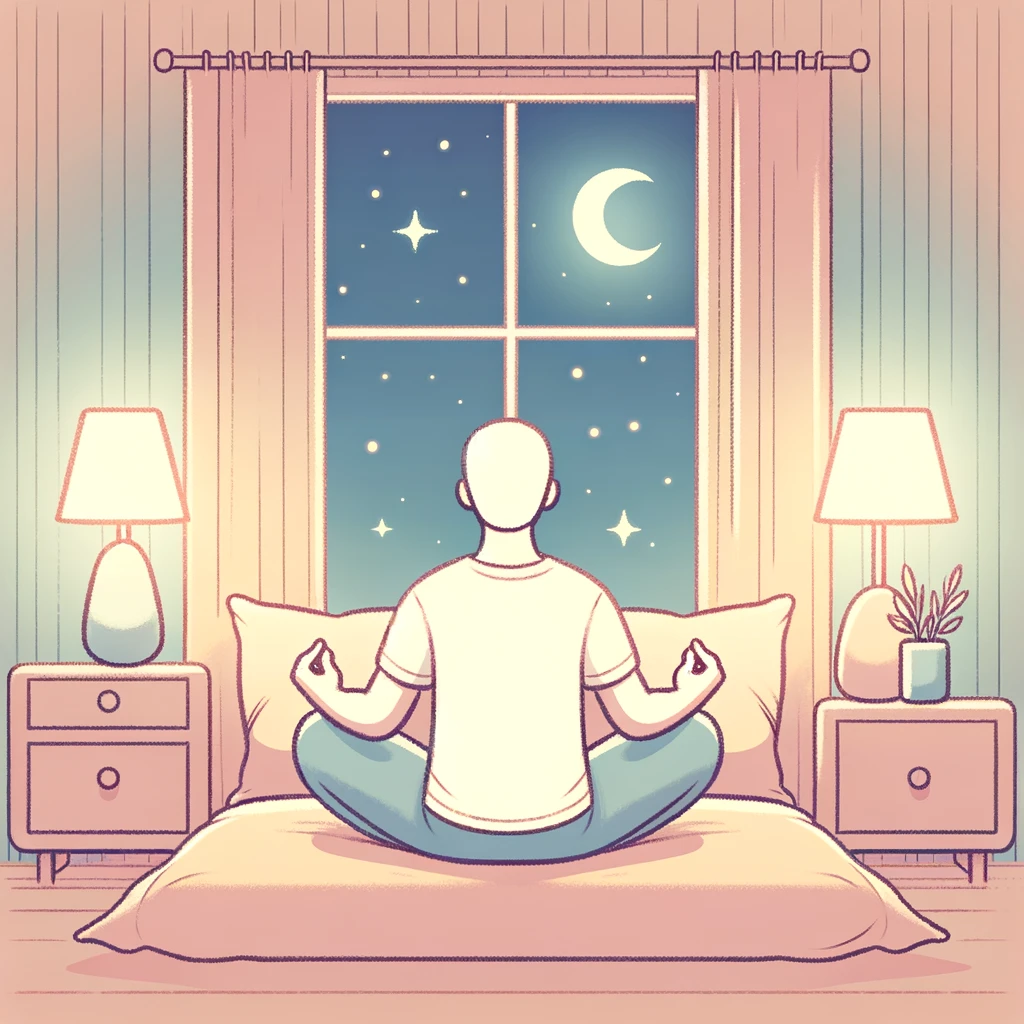Many people find themselves tossing and turning at night, yearning for a good night’s rest. This lack of sleep can have a significant impact on our daily lives, affecting our mood, energy levels, and even our health.
But what if there was a natural, drug-free way to improve your sleep quality? Meditation practices have been shown to be remarkably effective in promoting restful sleep. In this article, we’ll explore the powerful connection between meditation and sleep and how you can harness this connection to finally get the sleep you deserve.
Understanding the Sleep-Meditation Connection
How does meditation impact sleep? This question might have crossed your mind as you search for solutions to improve your nightly rest. Meditation, at its core, is about cultivating a state of mindfulness and relaxation, which directly translates into better sleep quality. By engaging in meditation, you train your mind to focus on the present moment, reducing the incessant mental chatter that often keeps you awake at night.
But don’t just take our word for it; let’s look at the science. Numerous studies have demonstrated the positive effects of meditation on sleep. For instance, a study published in JAMA Internal Medicine found that participants who practiced mindfulness meditation experienced significant improvements in their sleep quality and had fewer symptoms of insomnia compared to those who did not meditate.
Another research highlighted how meditation can reduce the physiological markers of stress, such as cortisol levels, which in turn promotes a state of relaxation conducive to sleep.
Stress and anxiety are often the culprits behind restless nights. When your mind is preoccupied with worries and your body is in a constant state of alertness, falling and staying asleep becomes a challenge. Meditation helps mitigate these issues by activating the body’s relaxation response. Through regular practice, you can learn to calm your nervous system, making it easier to drift into a peaceful slumber.

Types of Meditation for Better Sleep
By incorporating these different types of meditation into your nightly routine, you can find the one that works best for you and enjoy more restful, restorative sleep.
Mindfulness Meditation
At its core, mindfulness meditation involves paying attention to the present moment without judgment. This practice helps you become more aware of your thoughts and feelings, allowing you to let go of the stress and worries that often keep you awake at night.
How does it work? Mindfulness meditation helps calm the mind by focusing on the present moment. When you meditate mindfully, you become aware of your breath, body sensations, and the flow of thoughts. This awareness helps break the cycle of racing thoughts and anxiety that can interfere with sleep. Research has shown that mindfulness meditation can reduce symptoms of insomnia and improve overall sleep quality.
Here’s how you can practice mindfulness meditation for sleep:
- Find a comfortable position: Sit or lie down in a comfortable position. Close your eyes and take a few deep breaths to relax.
- Focus on your breath: Pay attention to your breathing. Notice the sensation of the air entering and leaving your nostrils. If your mind starts to wander, gently bring your focus back to your breath.
- Observe your thoughts: As you meditate, thoughts will inevitably arise. Instead of getting caught up in them, simply observe them without judgment and let them pass.
- Practice regularly: Aim to meditate for at least 10-15 minutes each night before bed. Consistency is key to experiencing the full benefits.
Body Scan Meditation
This is another excellent technique for promoting relaxation and sleep. It involves mentally scanning your body from head to toe, bringing awareness to each part, and releasing any tension you might be holding.
The benefits are profound. Body scan meditation helps you connect with your physical sensations and release stress, making it easier to drift off to sleep. One study found that body scan meditation can significantly reduce sleep disturbances and improve sleep quality.
Here’s a step-by-step guide to practicing body scan meditation for sleep:
- Get comfortable: Lie down in your bed and make yourself comfortable. Close your eyes and take a few deep breaths.
- Start at the top: Begin by focusing on your head. Notice any sensations or tension in your scalp, forehead, and temples. Breathe deeply and imagine releasing the tension with each exhale.
- Move down gradually: Slowly move your attention down to your neck, shoulders, arms, and so on, all the way to your toes. Spend a few moments on each body part, noticing any sensations and consciously relaxing those muscles.
- Finish with deep breathing: Once you’ve scanned your entire body, take a few deep breaths and imagine a wave of relaxation flowing from your head to your toes.
Guided Meditation
Guided meditations are led by a narrator who provides instructions and helps you stay focused. They can be particularly effective for sleep because they remove the guesswork from the process, allowing you to simply follow along and relax.
The benefits of guided meditation for sleep are well-documented. Guided meditations can help you unwind, reduce anxiety, and prepare your mind and body for sleep. According to a study in Mindfulness, participants who used guided sleep meditations experienced significant improvements in sleep quality.
Here are some recommended resources and apps for guided sleep meditations:
- Headspace: Offers a variety of guided meditations specifically designed for sleep.
- Calm: Provides sleep stories and guided meditations to help you relax and fall asleep.
- Insight Timer: Features a wide range of free guided meditations, including many for sleep.
Breathing Exercises
The benefits of breathing exercises for sleep are significant. By focusing on your breath, you can shift your mind away from worries and into a state of relaxation. Research indicates that deep breathing exercises can activate the parasympathetic nervous system, promoting relaxation and sleep.
Here are some examples of breathing techniques for relaxation and sleep:
4-7-8 Breathing:
- Inhale: Breathe in quietly through your nose for a count of four.
- Hold: Hold your breath for a count of seven.
- Exhale: Exhale completely through your mouth for a count of eight.
- Repeat: Repeat this cycle three to four times.
Box Breathing:
- Inhale: Breathe in through your nose for a count of four.
- Hold: Hold your breath for a count of four.
- Exhale: Exhale through your nose for a count of four.
- Hold: Hold your breath again for a count of four.
- Repeat: Repeat this cycle for several minutes.

Creating a Bedtime Meditation Routine
Why is establishing a consistent routine so important? Think of your bedtime routine as a signal to your body and mind that it’s time to wind down and prepare for sleep. When you follow the same steps each night, you create a predictable pattern that helps train your brain to recognize when it’s time to relax. Consistency is critical to making meditation a natural part of your nightly ritual and reaping its full benefits.
Let’s start by setting up a calming sleep environment.
Your surroundings play a crucial role in preparing your mind and body for rest. Here are some tips to create a peaceful space conducive to sleep:
- Dim the lights: Lowering the light levels in your room signals to your brain that it’s time to wind down. Consider using soft, warm lighting.
- Eliminate distractions: Turn off electronic devices or place them in another room to avoid distractions. Consider using white noise or calming music if you’re sensitive to ambient noise.
- Comfort is key: Ensure your bedding is comfortable and your room is at a cool, comfortable temperature.
Now, let’s dive into a step-by-step guide to creating your bedtime meditation routine:
- Set a consistent time: Choose a time each night that works best for you, ideally 30 minutes before you plan to sleep.
- Begin with a calming activity: Engage in a relaxing activity such as reading a book, taking a warm bath, or listening to soothing music.
- Find your meditation spot: Sit or lie down in a comfortable position in a quiet part of your home. You can use a meditation cushion or lie on your bed.
- Focus on your breath: Start with a few deep breaths to center yourself. Close your eyes and take slow, deep breaths, inhaling through your nose and exhaling through your mouth.
- Choose your meditation technique: Whether it’s mindfulness meditation, a body scan, or guided meditation, stick to the technique that helps you relax the most. Follow the steps outlined in the previous section to guide you through your practice.
- Reflect on your day: Spend a few minutes reflecting on positive moments from your day. This can help shift your mind away from stress and towards gratitude and peace.
Incorporating meditation into your nightly rituals can be seamless and enjoyable. For instance, after a warm bath, you might spend 10 minutes meditating, or you could meditate for a few minutes after reading a chapter of your favorite book. By pairing meditation with activities you already enjoy, you’ll find it easier to make it a regular part of your routine.
Embracing Restful Nights with Meditation
Achieving a good night’s sleep doesn’t have to be an elusive dream. By incorporating meditation into your nightly routine, you can transform your sleep experience and wake up feeling refreshed and rejuvenated.
Remember, the journey to better sleep is a personal one. Experiment with different techniques to find what works best for you. Be patient with yourself, and stay committed to your practice. Over time, you’ll notice the profound impact meditation can have on your sleep and overall well-being.

Leave a Reply